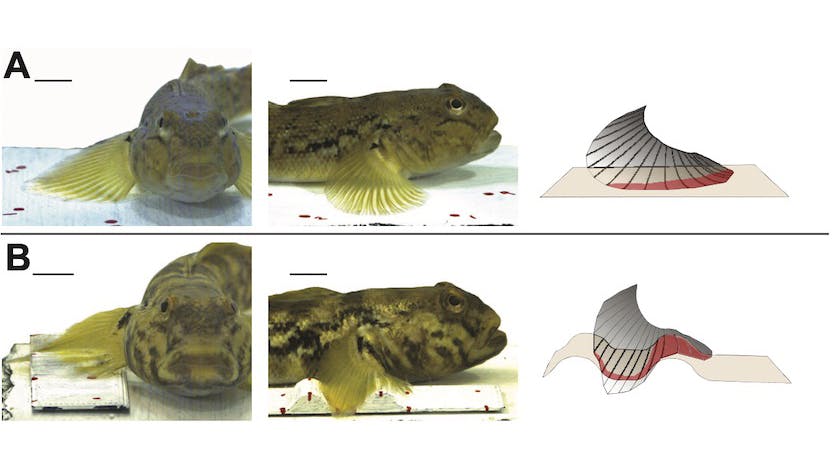Goby fish have fins as sensitive as fingertips

Human fingertips are exquisitely engineered to deftly detect the differences between surfaces and shapes, but we are not the only animals that touch objects. New research out of the University of Chicago has found that fish may have a sense of touch just as sensitive as many mammals, indicating that this trait likely evolved in a distant common ancestor.
The study was inspired by the observation that many species of fish navigate complex environments and touch varying surfaces with their fins. Graduate student Adam Hardy and his advisor Melina Hale, PhD, the William Rainey Harper Professor in the Department of Organismal Biology and Anatomy at UChicago, wondered whether fish may also be able to feel surface differences with their fins.
Their study, published Nov. 3, 2020, in the Journal of Experimental Biology, looked at this question in bottom-dwelling round goby fish, and found that goby fins are as touch sensitive as primate finger tips.
Before the team could begin unravelling the question, Hardy and Hale had to find a fish that seemed like it might require touch sensitivity for navigating its environment.
“Round gobies (Neogobius melanostomus) were a great choice for these experiments given that they are a bottom-dwelling fish that love to perch on rocks and other materials,” said Hardy, who biked from the university campus to Lake Michigan during the summer to catch the fish.
“It’s always a good day when you can go fishing for work,” he said with a chuckle.
After collecting a few gobies, Hardy placed the fish in tanks in the lab and filmed them as they maneuvered over a piece of slate or a wavy piece of plastic on the tank bottom, and also when they wedged themselves against the side of the tank.
He observed that the fish’s fins splayed out over each of the surfaces, contacting the structures like a hand laid upon them. Yet, to find out whether the fins were providing the fish with different touch sensations, Hardy knew he had to record nerve signals from individual fin rays.
Gently brushing a short horizontal bar moving along a fin ray toward the tip at speeds ranging from 5mm/s to 20mm/s, Hardy recorded the electrical signals in nerves as the bar moved over the fin. The responses indicated that the fins sensed when they were being touched. In addition, each nerve only sensed contact along a tiny portion of each fin ray, possibly allowing the fish to feel fine surface details. But the researchers faced another challenge: How could they determine if the fins were sensitive enough to detect fine variations, such as the differences between different grades of gravel?
This time, Hardy designed a rotating wheel with 2mm-wide ridges along the edge — separated by gaps of 3, 5 or 7mm — to mimic sediments ranging from coarse sand to granules and pebbles. He could then roll the wheels along the fish’s fin rays at varying speeds (from 20 to 80mm/s) and study the nerve signals the touch produced.
“It took numerous design iterations to create the wheels,” Hardy said. But, as he painstakingly recorded the nerve signals produced when the ridges contacted the fin rays, “the pattern of the nerves firing signals matched the pattern of the ridges moving across the skin even as the speed of the wheel increased.”
The gobies’ nerve responses indicate that they may be as sensitive to detecting coarse surface textures as the finger pads on primates such as macaque monkeys. “Primates are often held up as the gold standard in tactile sensitivity, so it was really exciting to see that fish fins exhibit a similar tactile response,” said Hardy.
He and Hale also suspect that the gobies’ tactical sensitivity may have originated far back in evolution. “This primate hand-like touch also suggests that the ability to detect surface differences via touch has been around a lot longer than we previously thought,” he said.
The study, “Sensing the structural characteristics of surfaces: Texture encoding by a bottom-dwelling fish,” was supported by the National Science Foundation (DGE-0903637, DGE-1144082) and the Office of Naval Research (N00014-18-1-2673).
This story is courtesy of The Company of Biologists.
